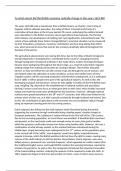To what extent did the British economy radically change in the years 1625-88?
The years 1625-88 mark a tumultuous time in British history, as Charles I rose to king of
England, until his ultimate execution, the ruling of Oliver Cromwell and Charles II’s
restoration all took place in the 63 year period. Of course, underlying this political turmoil
were alterations to the British economy, due to agricultural improvements, the thriving
cloth industry, the development of banking, but most significantly, international trade. The
extent of how radically these factors changed Britain’s economic situation can be measured
by their innovation, prevalence, monetary contribution and how long-lasting their effect
was, which proceed to show that overall, the economy drastically altered throughout the
duration of the period.
The agricultural advancement seen during this time, due to the influx of Dutch immigrants
and developments in transportation, contributed to the country’s changing economy.
Though having been introduced to Britain in the Tudor times, modern farming techniques
became more widespread throughout the Stuart reign, as a result of many Dutch migrants
seeking refuge from Catholic persecution by coming to Britain. They further educated
farmers on how to fertilise the soil with certain crops and through the use of manure, and
also helped widen the utilisation of water meadows, as they were skilled users of thew
irrigation system. All this increased production and therefore employment, as it is estimated
that in 1688, 1 million people were part of the agricultural industry. As well as this, the
developing transport infrastructure, shown by John Ogilby’s creation of the first British road
map, weighing 7kg, allowed for the establishment of national markets and specialised
farming. Farmers could now focus on what grew best on their land, which further increased
output and made the trade more profitable for the yeomanry. However, although national
markets were greatly beneficial in the 18th and 19th centuries, their effect was limited in the
primary years of their use, as it didn’t spread consistently through Scotland and Ireland. Due
to this, the contribution of agriculture to the economy was not completely radical, though
being an important starting point for the coming century.
Dutch migrants also influenced the cloth industry which flourished during the period,
supporting the economy through continually being a leading export, despite changes in
European preference. The ‘putting out’ system thrived in the first half of the 17th century,
due to the increasing population, as more labour was available. It benefited both merchant
and peasant, as the merchants could earn enough money to marry into gentry families,
whilst the peasants could make money from home using familiar skills. However, this was a
continuation of what already existed, as this method had been introduced during the
Middle Ages, simply becoming more widespread in the 17th century as the population grew.
In the second half of the 1600s, ‘new draperies’ made from lighter materials became
popular in Europe, which the British workforce did not have the skills to make, causing many
centres of the cloth industry to fall into decline. Nevertheless, Dutch migrants, who were
skilled weavers, pioneered new ‘worsted draperies’, which appealed to a wider market than
the traditional English wares, and taught British workers the weaving technique required to
produce the garments. As well as this, the immigrants introduced the important innovation
of the frame knitting machine, reducing the amount of time required to make the cloth. In
1681, Huguenots began to flee from persecution in France, many of whom were weavers,




